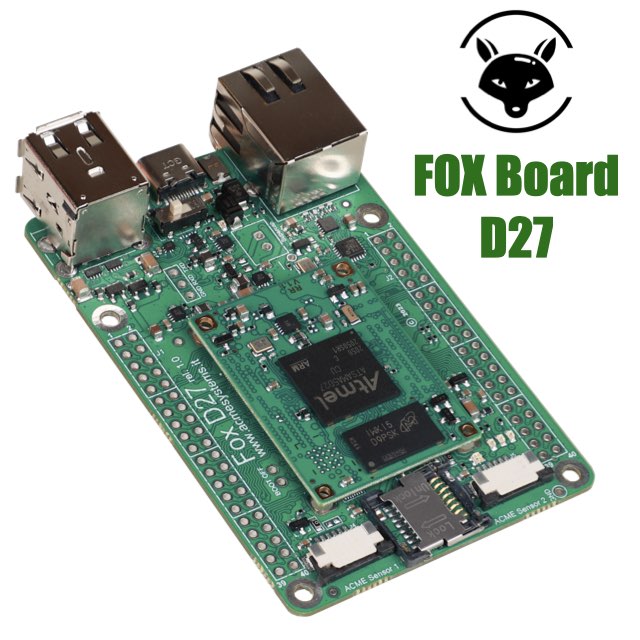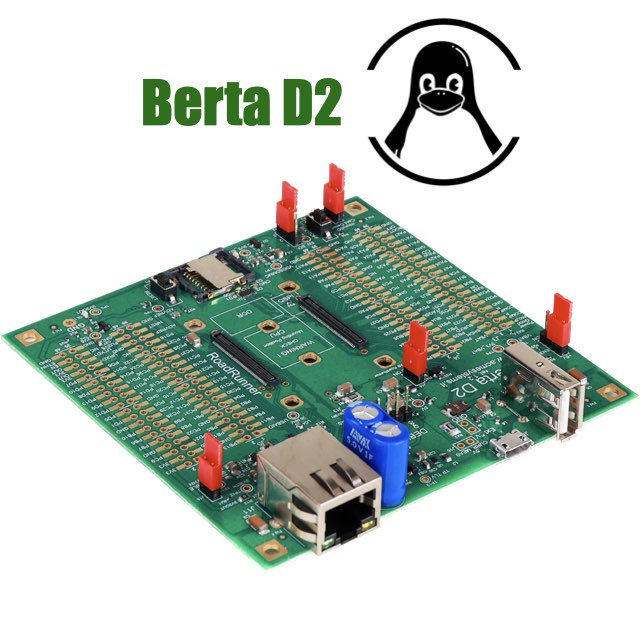Roadrunner technical documentation Buy
How to use the ADC lines
Tested on Linux Kernel: 4.19.78
Pinout of ADC lines
Up to 12 ADC lines are available on the RoadRunner SOM. Some of them are available also on Fox Board D27
| Signal | Description | Line | FOX D27 |
|---|---|---|---|
| 3.3V | 3.3 volt power line | ||
| AVDD | Clean 3.24V out for A/D circuitry | ||
| VREF | A/D voltage reference input | ||
| AGND | Analog GND | ||
| AD0 | Analog input 0 | PD19 | J2-09 |
| AD1 | Analog input 1 | PD20 | J2-10 |
| AD2 | Analog input 2 | PD21 | J2-11 |
| AD3 | Analog input 3 | PD22 | J2-12 |
| AD4 | Analog input 4 | PD23 | J1-13 |
| AD5 | Analog input 5 | PD24 | J1-10 |
| AD6 | Analog input 6 | PD25 | J1-12 |
| AD7 | Analog input 7 | PD26 | |
| AD8 | Analog input 8 | PD27 | |
| AD9 | Analog input 9 | PD28 | |
| AD10 | Analog input 10 | PD29 | J1-15 |
| AD11 | Analog input 11 | PD30 | |
| GND | Digital GND |
Enable the Linux Kernel ADC modules
To enable the ADC Linux driver and the IIO user space interface inside make ARCH=arm menuconfig:
Device Drivers --->
<*> Industrial I/O support --->
<*> Enable software IIO device support
<*> Enable software triggers support
Analog to digital converters --->
<*> Atmel AT91 ADC
<*> Atmel AT91 SAMA5D2 ADC
Follow this article to compile the Linux Kernel, enable the right drivers and use the right device tree definitions.
Configure the device tree
Edit the device tree source at arch/arm/boot/dts/at91-sama5d2_roadrunner.dts of your board adding these lines:
Insert this definition to enable the driver:
vddin_3v3: fixed-regulator-vddin_3v3 {
compatible = "regulator-fixed";
regulator-name = "VDDIN_3V3";
regulator-min-microvolt = <3300000>;
regulator-max-microvolt = <3300000>;
regulator-always-on;
regulator-boot-on;
status = "okay";
};
vddana: fixed-regulator-vddana {
compatible = "regulator-fixed";
regulator-name = "VDDANA";
regulator-min-microvolt = <3300000>;
regulator-max-microvolt = <3300000>;
regulator-always-on;
regulator-boot-on;
vin-supply = <&vddin_3v3>;
status = "okay";
};
advref: fixed-regulator-advref {
compatible = "regulator-fixed";
regulator-name = "advref";
regulator-min-microvolt = <3300000>;
regulator-max-microvolt = <3300000>;
regulator-always-on;
regulator-boot-on;
vin-supply = <&vddana>;
status = "okay";
};
adc: adc@fc030000 {
vddana-supply = <&vddana>;
vref-supply = <&vddana>;
pinctrl-names = "default";
pinctrl-0 = <&pinctrl_adc_default>;
status = "okay";
};
Insert this definition to select the pin to use:
pinctrl_adc_default: adc_default {
pinmux = <PIN_PD19__GPIO>,
<PIN_PD20__GPIO>,
<PIN_PD21__GPIO>,
<PIN_PD22__GPIO>,
<PIN_PD23__GPIO>,
<PIN_PD24__GPIO>,
<PIN_PD25__GPIO>,
<PIN_PD26__GPIO>,
<PIN_PD27__GPIO>,
<PIN_PD28__GPIO>,
<PIN_PD29__GPIO>,
<PIN_PD30__GPIO>;
bias-disable;
};
Generate the at91-sama5d2_roadrunner.dtb:
make ARCH=arm CROSS_COMPILE=arm-linux-gnueabihf- at91-sama5d2_roadrunner.dtb
Rename it in acme-roadrunner.dtb and save it inside boot partition.
Use the ADC from command line
cat /sys/bus/iio/devices/iio\:device0/in_voltage0_raw
cat /sys/bus/iio/devices/iio\:device0/in_voltage1_raw
...
cat /sys/bus/iio/devices/iio\:device0/in_voltage11_raw
More in-depth examples are available from Microchip at:
Python example
Without using mpio library:
import time
def get_adc(id):
with open("/sys/bus/iio/devices/iio:device0/in_voltage%d_raw" % id) as f:
value=int(f.read())
return value
while True:
print "ADC value: %d" % get_adc(0)
time.sleep(1)
Using mpio library:
from mpio import ADC
import time
while True:
adc = ADC(0)
print "ADC value: %d" % adc.value(0)
time.sleep(1)
Links
- Using the SAMA5D2-compatible ADC device
- Manage the GPIO lines using the Microchip Peripheral I/O Python Package
- Microchip ADC class source
- How to Use the SAMA5D2 ADC Under Linux
- Patch: Add fixed regulators for the ADC
- Use of the AT91 ADC driver by Atmel
Related products

- CPU Microchip SAMA5D27
- Cortex A5 @ 500 MHz
- Low power consumption:
Suspend to RAM mode 10mW
Full speed: 396mW - Debian, Buildroot and Yocto Linux
- Fully open source drivers

- Low power consumption
- Two USB Host 2.0 ports (one configurable as USB client on the USB-C connector)
- One 10/100 Mbit/s Lan port
- 2 Acme Sensor ports
- Huge set of GPIOS, SPI, I2C and serial lines






